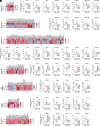Exercise preserves physical fitness during aging through AMPK and mitochondrial dynamics
- PMID: 36595699
- PMCID: PMC9926278
- DOI: 10.1073/pnas.2204750120
Exercise preserves physical fitness during aging through AMPK and mitochondrial dynamics
Abstract
Exercise is a nonpharmacological intervention that improves health during aging and a valuable tool in the diagnostics of aging-related diseases. In muscle, exercise transiently alters mitochondrial functionality and metabolism. Mitochondrial fission and fusion are critical effectors of mitochondrial plasticity, which allows a fine-tuned regulation of organelle connectiveness, size, and function. Here we have investigated the role of mitochondrial dynamics during exercise in the model organism Caenorhabditis elegans. We show that in body-wall muscle, a single exercise session induces a cycle of mitochondrial fragmentation followed by fusion after a recovery period, and that daily exercise sessions delay the mitochondrial fragmentation and physical fitness decline that occur with aging. Maintenance of proper mitochondrial dynamics is essential for physical fitness, its enhancement by exercise training, and exercise-induced remodeling of the proteome. Surprisingly, among the long-lived genotypes we analyzed (isp-1,nuo-6, daf-2, eat-2, and CA-AAK-2), constitutive activation of AMP-activated protein kinase (AMPK) uniquely preserves physical fitness during aging, a benefit that is abolished by impairment of mitochondrial fission or fusion. AMPK is also required for physical fitness to be enhanced by exercise, with our findings together suggesting that exercise may enhance muscle function through AMPK regulation of mitochondrial dynamics. Our results indicate that mitochondrial connectivity and the mitochondrial dynamics cycle are essential for maintaining physical fitness and exercise responsiveness during aging and suggest that AMPK activation may recapitulate some exercise benefits. Targeting mechanisms to optimize mitochondrial fission and fusion, as well as AMPK activation, may represent promising strategies for promoting muscle function during aging.
Keywords: C. elegans; aging; exercise; mitochondrial fission; mitochondrial fusion.
Conflict of interest statement
The authors have stock ownership to disclose, E.T.C. is a founder and equity holder in Matchpoint Therapeutics.
Figures





Comment in
-
A worm's life: AMPK links muscle mitochondrial dynamics to physical fitness and healthy aging in Caenorhabditis elegans.J Cardiovasc Aging. 2023;3(3):25. doi: 10.20517/jca.2023.14. Epub 2023 May 4. J Cardiovasc Aging. 2023. PMID: 37304322 Free PMC article. No abstract available.
References
-
- Taguchi N., Ishihara N., Jofuku A., Oka T., Mihara K., Mitotic phosphorylation of dynamin-related GTPase Drp1 participates in mitochondrial fission. J Biol. Chem. 282, 11521–11529 (2007). - PubMed
Publication types
MeSH terms
Substances
Grants and funding
LinkOut - more resources
Full Text Sources
Research Materials
Miscellaneous

